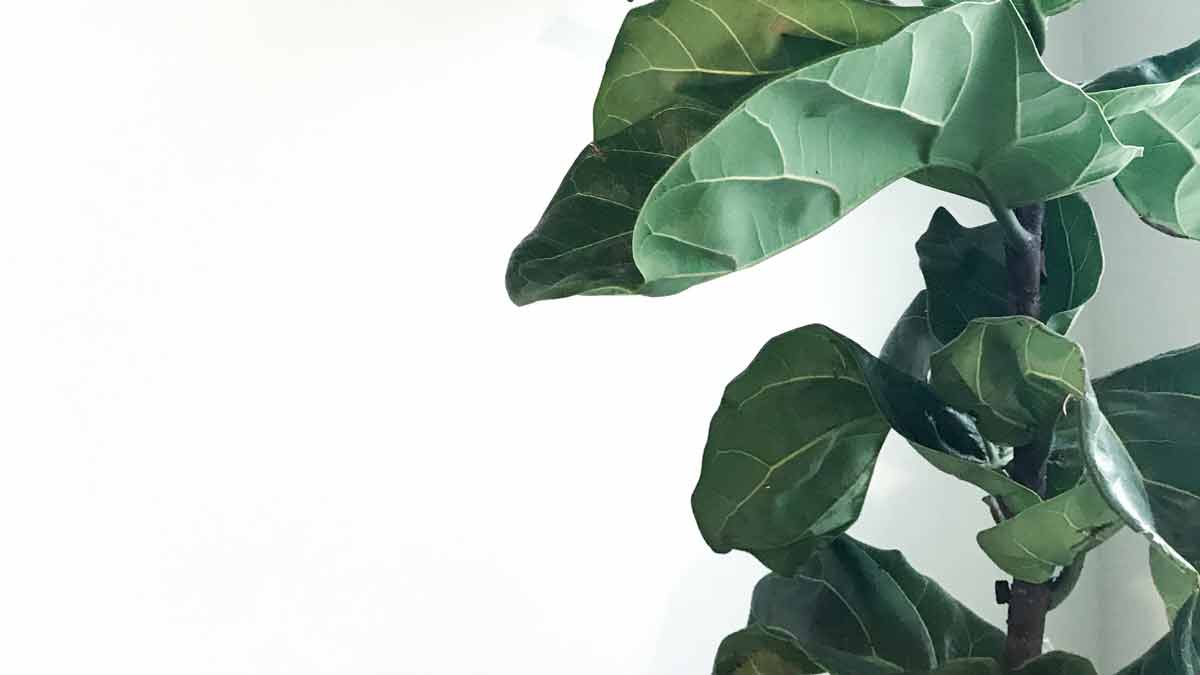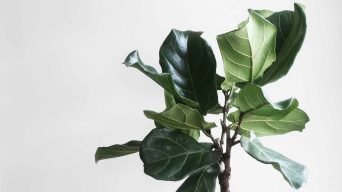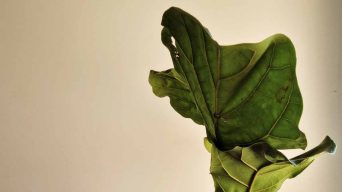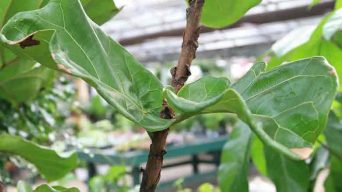Fiddle Leaf Fig leaves can droop for various reasons, including under-watering, over-watering, environmental changes, root shock, and inadequate sunlight. To prevent drooping, maintain a consistent watering schedule, ensuring that the top 50-75% of the soil is dry before watering. Additionally, provide your Fiddle Leaf Fig with appropriate lighting conditions, and avoid sudden changes in its environment.
The Ficus lyrata, also known as the Fiddle Leaf Fig, is an excellent houseplant choice for any home, as its large, glossy leaves make a bold statement and add a touch of greenery to any room.
But what do you do when your Fiddle Leaf Fig leaves start drooping?
Drooping leaves can be caused by several things, including too much or too little water, too little light, and even stress.
However, a few simple solutions can help get your Fiddle Leaf Fig back to its healthy self in no time!
Why Are My Fiddle Leaf Fig Leaves Drooping and How To Fix It?
Fiddle Leaf Figs are one of the most popular houseplants for a reason: they’re stunning.
But even the most beautiful plants can have problems, and drooping leaves are a common issue with Fiddle Leaf Figs.
To revive your Fig plant and bring those leaves back to their upright position, it’s essential first to understand why the leaves are drooping in the first place.
Here are seven possible reasons for your Fiddle Leaf Fig’s droopy leaves and what you can do about it.
1. Lack of Water
As any plant lover knows, watering is essential for the health of your plants.
Without water, plants will quickly begin to wilt and die.
This is because water is vital for photosynthesis. Photosynthesis is crucial for plants to survive, as it helps them convert sunlight into energy and absorb nutrients from the soil—necessary for the production of food and other essential compounds that the plant needs to stay healthy.
In addition, water helps to keep plants cool in hot weather and prevents them from becoming dried out and brittle.
However, if you underwater your Fiddle Leaf Fig, the leaves will droop as the plant tries to conserve moisture.
Signs of Underwatering
When a Fiddle Leaf Fig is underwatered, the leaves will droop and wilt.
The leaves may also turn yellow or brown and feel dry to the touch, and the stems will become weak and can snap easily.
In addition, the soil will feel dry and dusty when you touch it.
Treating Underwatering Issues
The problem is that the Fiddle Leaf Fig is not getting enough water, so the first step is to check the moisture level of the soil to determine if there is an underlying issue that needs to be addressed.
If it’s dry, it’s time to water your plant.
Be sure to use filtered or distilled water if your tap water is high in chlorine or other minerals that could be harmful to your plant.
Allow the water to soak into the potting soil until it begins draining out of the pot’s bottom.
Once the plant has had a good drink, you should see an improvement in the leaves within a few hours.
2. Too Much Water
While plants need water to survive, it’s also possible to overwater them.
When a plant is overwatered, the roots become waterlogged and begin to rot, depriving the plant of oxygen and ultimately leading to its death.
This can happen if the pot lacks good drainage or you forget to check on your plant and water it too often.
Overwatering is just as harmful to plants as underwatering and can lead to drooping fig leaves, yellowing leaves, and root rot.
Signs of Overwatering
Overly saturating your Fiddle Leaf Fig with water may cause its leaves to sag and become limp.
The leaves may also turn yellow or brown and feel mushy to the touch.
The soil will feel soggy and wet when you touch it, and water may pool at the bottom of the pot.
Overwatered Fiddle Leaf Fig plants are also more susceptible to fungal diseases such as root rot.
Treating Overwatering Problems
If your plant is overwatered, the first thing you need to do is stop watering it.
Using your finger, check the soil of your plant to determine if it is dry before deciding whether to water it; if it feels dry to the touch, it is time to water, but if it is still damp, you should wait until it is dry to the touch before watering again.
You may also need to repot your plant in fresh, dry soil.
Repotting your plant in fresh, dry soil is an important step in keeping it healthy, as it helps to ensure that the soil is not too wet and that the roots have enough room to grow, allowing the plant to take up the necessary nutrients and water it needs to thrive.
Be sure to choose a pot with good drainage to prevent the roots from becoming waterlogged again.
3. Low Humidity
Fiddle Leaf Figs are native to tropical rainforests and prefer high humidity.
In their natural habitat, the air is always warm and moist.
But in our homes, the air is often dry, especially in the winter when we have the heat on.
Low humidity can cause problems for Fiddle Leaf Figs, including drooping foliage.
Detecting Insufficient Humidity
Fiddle leaf figs are a beautiful tropical plant that can add life to any room.
However, they can be finicky when it comes to humidity levels.
If the air is too dry, Fiddle Leaf Fig leaves will curl and brown at the edges and tips.
On the other hand, if the air is too moist, then Fiddle Leaf Fig leaves will develop brown spots.
So how can you tell if your fiddle leaf fig needs more humidity?
There are a few telltale signs.
- Check the leaves for browning or curling. If you see either of these, it’s a good indication that the air is too dry.
- Take a look at the soil. If it’s bone-dry, that’s another sign that the plant needs more moisture.
- Touch the leaves. If they feel crispy or papery, that’s an indication that they’re not getting enough moisture from the air.
Addressing Low Humidity
You can do a few things to increase the humidity around your Fiddle Leaf Fig tree.
First, you can mist the leaves with water every day.
You can also place the pot on a tray of pebbles and water, which will help to increase the humidity around the plant.
Or you can invest in a humidifier, which will help to keep the air around your plant moist.
4. Insufficient Sunlight Exposure
Fiddle Leaf Fig leaves will droop if the plant is not receiving adequate sunlight.
Insufficient sunlight inhibits the plant’s ability to produce the necessary energy for photosynthesis and food creation, depriving it of the vitality required for thriving.
Although the plant can endure low-light conditions, it will not flourish and may eventually perish.
Fiddle Leaf Figs prefer bright indirect light but can also tolerate some direct sunlight.
Assessing the Light Requirements
Generally, Fiddle Leaf Figs (Ficus lyrata) prefer bright, indirect sunlight.
However, each plant is different; some may need more or less sunlight than others.
If you’re unsure whether your plant is getting enough light, there are a few telltale signs to look for.
- Check for brown or yellow leaves. This is a sign that the plant is not getting enough light and is struggling to photosynthesize.
- Take a look at the overall shape of the plant. If it’s leaning towards the light source, that’s a good sign that it needs more sun.
- If the leaves are small and pale, that’s another indication that the plant could use more bright light.
Optimizing Sunlight Exposure
If your plant is not getting enough sunlight, the best thing to do is move it to a brighter spot.
Make sure to gradually acclimate your plant to direct sunlight, as too much sun can scorch the leaves.
Start by moving it to an area with bright indirect sunlight and slowly adding more direct sun each week.
Fiddle Leaf Fig plants need at least 5 hours of sunlight per day to thrive.
South- or west-facing windows are typically the best spots for Fiddle Leaf Figs.
These locations will give the plant the bright, indirect sunlight it needs to grow.
5. Temperature Stress
Fiddle Leaf Figs are tropical plants and prefer warm, humid conditions.
They cannot tolerate cold temperatures and will start to drop their leaves if they get too cold.
The ideal temperature for a Fiddle Leaf Fig is between 65°F and 75°F.
However, they can tolerate temperatures as low as 50°F for short periods.
On the other hand, they will experience stress if the temperature gets much higher than 80°F.
Signs of Temperature Stress
There are a few signs to look for if you think your Fiddle Leaf Fig tree is stressed by the temperature.
The first is yellow or brown leaves. This is a sign that the plant cannot photosynthesize properly and is struggling to survive.
You may also notice that the leaves are dropping off the plant.
This is a sign that the plant is experiencing severe stress and cannot recover.
If the leaves are wilted or limp, that’s another indication that the plant is not doing well.
Finally, if the plant’s stem is soft or mushy, that’s a sign that it has been damaged by the cold and is not likely to recover.
Mitigating Temperature-Related Stress
If you suspect that your fiddle leaf fig is stressed by the temperature, you can do a few things to help.
- Make sure that the plant has enough water. Figs are native to tropical climates and need regular watering to stay healthy. However, be careful not to overwater, as this can lead to stress.
- Provide the plant with some protection from the sun. Too much direct sunlight can scorch leaves and cause stress. If possible, move the plant to a spot where it will receive filtered light instead.
- Improve the ventilation around the plant. Poor air circulation can cause temperatures to fluctuate, which can stress the plant. If possible, open a window or place a fan near the fiddle leaf fig to help improve airflow.
By taking these steps, you can help reduce stress and keep your plant healthy.
6. Pest Infestation
One of the biggest problems with Fiddle Leaf Figs is pest infestation, which can induce stress and compromise the plant’s health if not promptly addressed.
The most common pests that attack these plants are aphids, mealybugs, and scale insects.
Aphids are small, green insects that feed on the sap of plants.
Mealybugs are white, fuzzy insects that extract the juices from plants.
Scale insects are small, brown insects that attach themselves to the stems of plants and feed on the sap.
All of these pests can cause severe damage to a Fiddle Leaf Fig, resulting in yellowing and dropping of leaves, and in extreme cases, they can even kill the plant if left untreated.
Identifying Pest Infestations
There are a few signs to look for if you think your Fiddle Leaf Fig has pests.
The first is small, white insects on the leaves or stems of the plant. These are mealybugs, and they will damage the plant if left untreated.
Another sign of pests is small, brown insects on the plant’s stems. These are scale insects and will also damage the plant if left untreated.
Finally, you may notice that the plant leaves are yellowing or dropping off.
This is a sign that the plant is stressed by the pests and is not likely to recover.
Managing and Preventing Pests
If you think your fiddle leaf fig has pests, you can do a few things to help.
The first is to remove the pests by hand. Gently remove the pests from the plant with a cotton swab or a soft cloth.
To further protect your plants from pests, you can use a mild detergent solution to wipe down the leaves and stems of the plant, ensuring that any remaining pests are removed and that the plant is free from any potential contaminants.
If the infestation is severe, you may need to use an insecticide.
Read the label carefully and follow the instructions to avoid harming the plant.
Remedies such as neem oil can be used to help protect plants from pests and diseases without harming them and can be an effective way to provide relief from any potential damage caused by insects or other environmental factors.
Neem oil is a natural substance that kills pests but is safe for plants.
7. Transplant Shock
When a Fiddle Leaf Fig is moved to a new location, it can experience transplant shock.
This is a condition where the plant cannot adjust to its new environment.
Transplant shock can be caused by several factors, including temperature, light, or water changes.
It can also be caused by damage to the roots during the transplanting process.
Identifying Transplant Shock Symptoms
If you have just moved or repotted your Fiddle Leaf Fig and start to see droopy leaves, it may be suffering from transplant shock.
Transplant shock occurs when a plant is moved from one environment to another, and it can be a difficult period for the plant as it adjusts to its new home.
The symptoms of transplant shock can vary but typically include wilting, yellowing, and stunted growth.
In general, it will have an overall unhealthy appearance.
Managing Transplant Shock
Usually, the best approach for a plant experiencing transplant shock is to give it time to adjust to its new environment.
When transferring a plant to a new container, it is important to ensure that the container is large enough to allow for adequate root growth.
Gradually acclimate the plant to its new environment by slowly introducing it to different temperatures, light levels, and water levels to prevent transplant shock.
Do not fertilize the plant during this time, as it will be stressed and unable to effectively utilize the fertilizer.
If the plant’s condition does not improve after a few weeks, you may need to consider changing its environment by transplanting it to a new location or pot, giving it the best chance to thrive.
How To Prevent Fiddle Leaf Fig Leaves From Drooping
Fiddle Leaf Fig leaves are beautiful but can be a bit finicky.
To keep your plant healthy and prevent the leaves from drooping, here are a few things to keep in mind:
- Water the plant regularly, but do not overwater. The soil should be moist but not soggy.
- Place the plant in an area with bright indirect light.
- Fertilize the plant monthly during the growing season.
- Prune the plant as needed to remove dead or damaged leaves.
- Inspect the plant regularly for pests and diseases.
- Repot the plant every two years or as needed.
- Avoid sudden changes in temperature or light.
- Be patient! Fiddle Leaf Fig leaves can take time to adjust to a new environment.
With some care, your Fiddle Leaf Fig plant will be healthy and happy for years to come!
Final Thoughts
Drooping Fiddle Leaf Fig leaves can be a source of frustration for many indoor plant owners, as they can be difficult to revive and can cause the plant to look less-than-healthy if not addressed quickly, but with proper care and attention, these plants can be kept healthy and vibrant for years to come.
There are several possible causes, but the most common are improper watering and lack of light.
Fortunately, a few simple solutions can help get your Ficus lyrata back on track.
Proper plant care is essential to the health of your Fiddle Leaf Fig, including providing the right amount of sunlight, water, and fertilizer, as well as monitoring the temperature and humidity levels in the room to ensure it is not too hot or too cold, and making sure the soil is well-draining and not overly saturated.
With a bit of care, your Fiddle Leaf Fig will return to its leafy self in no time!







